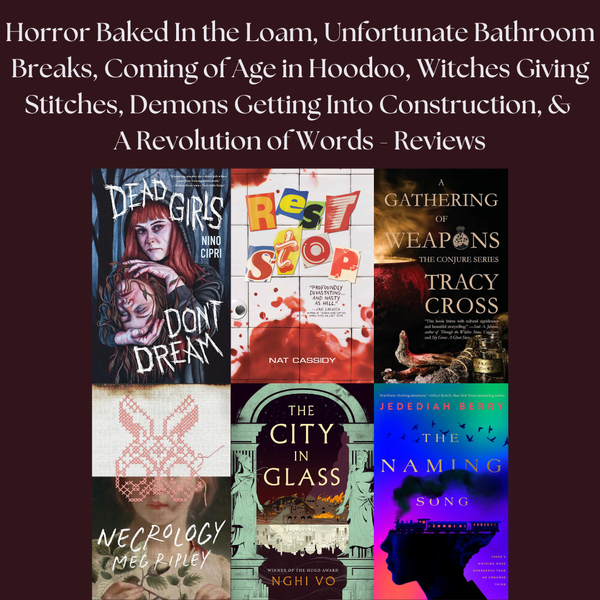Redemption By Way of Fire & Blood - Reviews feat. Catherine McCarthy, Nick Medina, Paul Tremblay, Beth Hetland, and M. Lopes da Silva
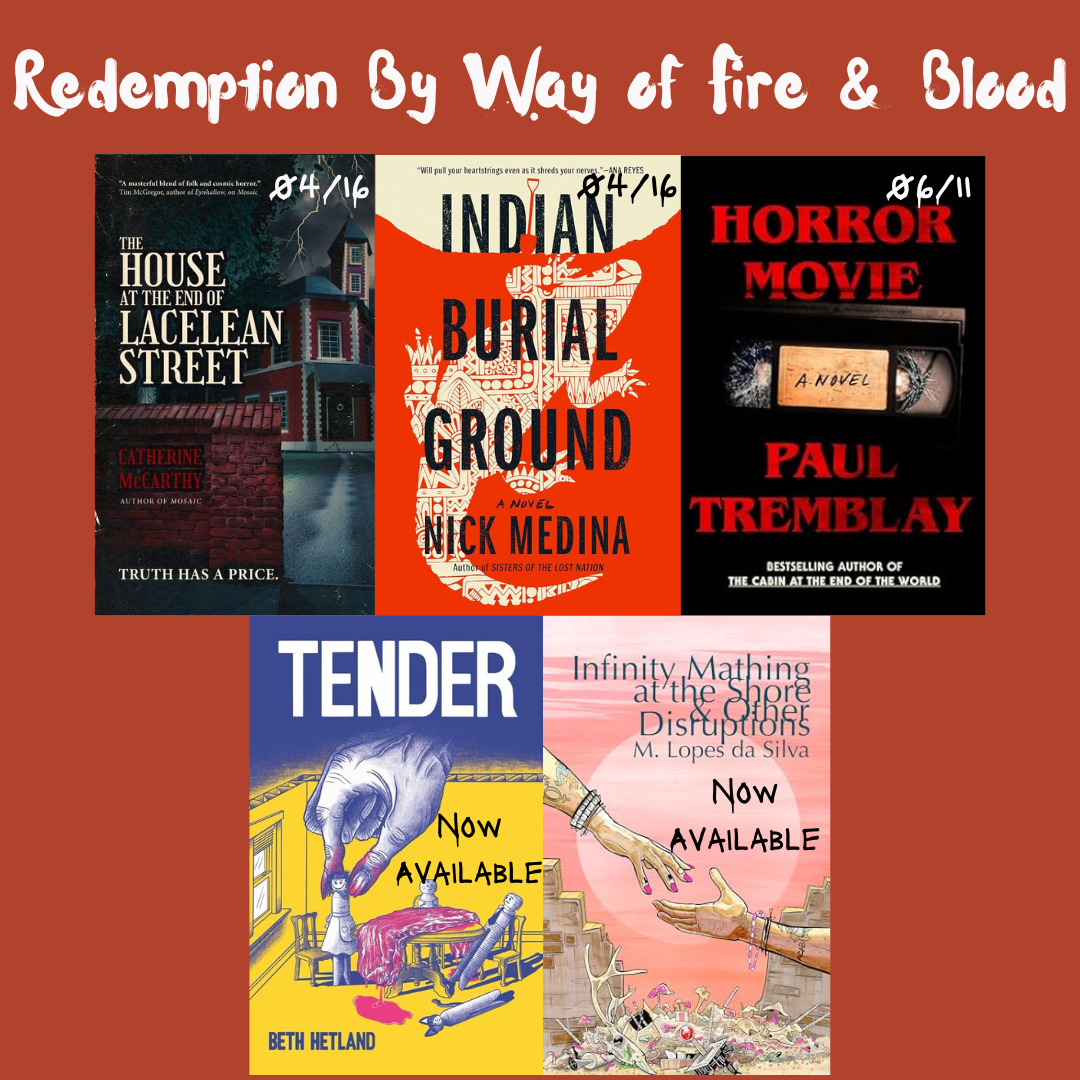
In Western definitions of redemption, the focus of salvation is typically placed upon self. You're acting to save or be saved from evil and sin. We've seen all manner of heroes, villains, anti-heroes, and countless archetypes seek and find redemption through various forms of action, or even inaction.
The beauty of Fiction often lies in how an author uses or deconstructs these archetypes, upending our perceptions of who and what deserves a form of redemption. As a culture founded upon puritanical ideals/morality, these perceptions most often skew in fashions black and white, as well as carceral–hoping to keep the lines of redemption and salvation as neat and agreeable as possible.
However, humanity has never fit within neat lines. Our best stories depict the various shades of color spectrum to show how flexible, flimsy, and adaptable applications of redemption truly become under constructed law and morality.
Despite our best efforts, chaos continues to cultivate when and where we least expect it.
Today's reviews will focus on recent and upcoming titles that embrace the chaotic mutability of these concepts.
The House at the End of Lacelean Street by Catherine McCarthy, Dark Matter Ink
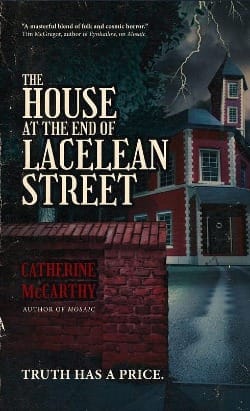
Looking to win the competition for coolest book cover of 2024, Catherine McCarthy returns with yet another novella that completely recontextualizes horror and gothic fiction, with The House at the End of Lacelean Street functioning more as a dark fantasy than a strict adherence to the former. Being that the entirety of her repertoire up to this point functions in largely similar ways, none of this should come as a surprise to her fans.
Calling to mind the more philosophical plots of C.S. Lewis, particularly the breathtaking novel, The Great Divorce, McCarthy weaves a mystery surrounding three strangers who board a strange bus that leads them to the eponymous Leacelean Street. Even stranger, the street itself seems to be home to only a beautiful, yet terrifying gothic structure that seems to have anticipated their arrival.
Considering her extensively astute attention to detail when it comes to mystery, readers are just as clueless as our protagonists, all of whom suffer a unique and recent amnesia, only incrementally cleared by letters left them by the house. All they are told is that the truth will reveal itself as long as they follow the rules of the house and attend the daily "lessons," which take place in an extensive library within the building.
What follows is a shifting mosaic from sinister to tender–surreal to surrender. The truths that brought these complete strangers together are dark, but the house does not wish to necessarily punish them. While the cosmic force at the center of the house remains an utter mystery, its benevolence is as redemptive as it is heartbreaking and heartwarming.
Where many narratives of old would focus on profiling the misdeeds and punishment of these characters, McCarthy is far more interested in forgiveness, forcing characters and readers alike to sit with their supposed "sins," not to instill suffering, but rather allow the truth and circumstance of their actions to rest in their own hands, prompting themselves to mete out forgiveness and redemption.
At fear of spoiling the most impactful moments of the book, I will refrain from speaking much more about the plot, as going in with little knowledge of its third act is tantamount to its emotional resonance. While I compared this story to The Great Divorce, this novella is far more unique than the other, offering something a little different than Lewis's theology. The House at the End of Leclean Street is one to likely stick with you long after you close its pages, feeling transformed, with your heart and mind's capacities expanded.
Yet again, Catherine McCarthy shows us just how much of a creative and powerful force she is.
Indian Burial Ground by Nick Medina, Berkley
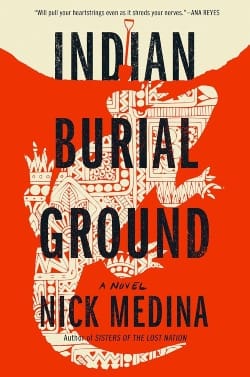
I missed out on initially reviewing Nick Medina's debut last year, Sisters of the Lost Nation, mainly because the book floored me so much I wasn't sure how to even write about it. A tightly wound mystery with a powerfully heartbreaking ending, Medina wove mythology with the horrific reality of the ongoing epidemic of missing Indigenous women across the country, delivering a tale so untethered to genre it basically dared you to try.
My quiet awe greatly contributed to the hype I felt surrounding his next novel, Indian Burial Ground, which finally arrives next week. Feeling almost as a spirited sequel to his debut, this novel follows the past and present threads of Noemi and her uncle Louie, who has recently returned to the reservation after spending several decades away. In an unfortunate turn, Louie's homecoming coincides with the mysterious, sudden death of Noemi's boyfriend Roddy, who threw himself in front of a car, seemingly being followed by a coyote.
This inciting incident sets in motion a mystery and a reckoning as Noemi and Louie seek to find answers, all while Louise contends with the tragic and horrific events of his past that sent him away from Noemi in the first place. Indian Burial Ground is greatly connected to its horror throughline, though the horror is once again mythological. Louie is a professor whose focus lies in Indigenous folklore, and we learn just how intrinsically the events of the past connect to this life-long focus.
I adore this novel. Where Sisters of the Lost Nation arrested my attention in so many ways, Indian Burial Ground completely ensnared it. The depth and complexity with which Medina intertwines "reality" and myth feels much in concert with Alicia Elliott's masterful debut, And Then She Fell, which utilized myth in a deeply personal and transformative way. Medina uses this novel to explore themes of addiction, trauma, and suicide, showcasing just how tied to mythology these experiences can be, as well as the violent history of colonialism.
Medina presents an even clearer display of his talents and craft as a storyteller, giving the audience only little bits of the past to propel the narrative, but leaving the hardest-hitting bombshells for the very end–and I cannot stress how hard these hits actually are. Be sure to keep your emergency tissue box by your side at all times, because the ending is one for the ages that would make Tommy Orange proud. Its grappling with concepts of redemption are richly complex, leaving room for the humanity that continues to flourish and fight amongst its supernatural/mythological events. Louie's arc in particular is an excellent feature of this, tapping into further discussions of masculinity and honor.
Where our culture sometimes clings to the concept of "sophomore slumps," Indian Burial Ground is the exact opposite for Medina, cementing his lyrical voice and meticulous detail to story and mythology. As always, I urge readers to spend time with Indigenous fiction, and especially Indigenous horror, and this book should absolutely be placed in your most immediate TBR pile.
Horror Movie by Paul Tremblay, William Morrow
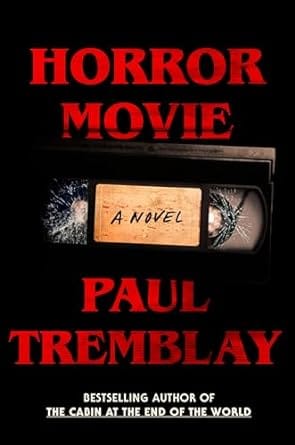
It would not be a new year in horror without a new release from the genre's favorite shy punk, Paul Tremblay, and boy oh boy does Paul deliver in 2024.
Dialing the notch back upward from the somewhat subtler horror of 2022's The Pallbearers Club, Tremblay tackles the world of lost movies, following the mysterious production of the titular horror film created by a passionate group of indie filmmakers in the 90's that went on to live in infamy following its tragic "completion," but was never released.
The story of its rise and fall and rise again is told through the eyes of our unnamed narrator, whose villain in "The Thin Kid" becomes the focus of the more strange happenings surrounding the production. Keeping the audience on their toes, the narrator flits between earnest, empathic self-depreciation and grief, as well as moments of unease, leading ones guard to rise back up. Tremblay has always been one to perfectly straddle these nebulous lines and Horror Movie is no exception.
Interspliced with the narrator's present day reflections of the seemingly mad decision to "reboot" the film is the original script, written by one of the troubled creator/actors, Cleo. Folks, when I tell you this fake movie sounds like an all-timer in terms of experimentation in the genre, I say that with my full chest. The ways in which Cleo/Tremblay exploits classic tropes to provide a meditative reinvention of the then-burgeoning crop of meta horror are truly inspiring and this movie would make a killing if it was real (looking at you, Hollywood, but NOT at you, Mr. Shyamalan).
Being that Tremblay has been at this game for several decades at this point, as well as a majority of his books crafting very self-aware themes, Horror Movie's best strength lies in how it feels like an amalgamation of his work up until this point. Particularly, this acts as a continuation of what A Head Full of Ghosts and The Pallbearers Club set before, melding the coming of age and self aware pastiches to concoct its own wholly new monster. The radical complexities and contradictions of humanity have always been what's most terrifying in his stories, while the supernatural elements appear more tenuous and dreamlike.
All of this said, the book is best experienced going in as unaware of the plot as possible, so I will wrap things up here. To conclude, Horror Movie is an outstanding addition to not only Paul Tremblay's catalog, but also to the growing cannon of books exploring lost/analog/found-footage media. It's commentary is razor-sharp, especially coming from someone as passionate about the genre as Paul. A clever, audacious, heartbreaking, and most importantly, terrifying novel that is truly impossible to forget. Be sure to get one of the first editions, cuz it's going to have red-edged pages!
Tender by Beth Hetland, Fantagraphics
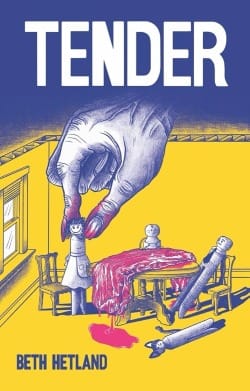
Last month I finally visited Partner & Son's in Philadelphia, a comics store that focuses on independent and local artists. The store is so much of what I dreamed it to be, showing me so many creators and comics I've never heard of. They also feature lots of titles from one of my favorite indie publishers, Silver Sprocket. One of the titles I purchased was a new Fantagraphics book with a body horror bent, illustrator Beth Hetland's Tender.
A surreal and visceral exploration of the lengths some go to achieve motherhood, as well as the immense body horror some may experience when they feel their body betrays them, our central protagonist, Carolanne, seeks the comfort of the American Dream. When she begins a romance with one of her co-workers, it seems as though these dreams will come true, but when their child is delivered stillborn, not only their relationship fractures, but we see the trauma of losing this dream fracture her own sense of reality and self.
Alternating between little and intricate detail, as well as a keen use of color and darkness, Hetland's style lends perfectly to what quickly descends into a horrific tale of agency attempted in a social narrative that refutes it. Carolanne becomes her own harbinger as she attempts to create another child without her husband, feeding pieces of her own skin to this new child, growing in unease until its shocking and heartbreaking climax.
The visuals, whether within Carolanne's reality or her terrifying nightmares, are harrowing, sparing no details when delivering Hetland's central theme, yet practicing its own restraint when wanting you to sit and question what you're seeing. To experience Tender is to surrender your senses to every panel, often feeling the true bodily violence as if you are Carolanne, yourself.
This graphic novel pairs excellently with the works of authors such as Eve Nash, Rachel Yoder, and the many more who have explored motherhood and bodily autonomy in the last several years. Tender is absolutely not for the faint of heart, however, it is a disturbing blast that plays with the senses as many of the best graphic novels do. If you love the styles of Emily Carroll, Katie Skelly, Daniel Clownes, and Charles Burns, this is one you should absolutely pick up.
Infinity Mathing at the Shore & Other Disturbances by M. Lopes da Silva, Weirdpunk Books
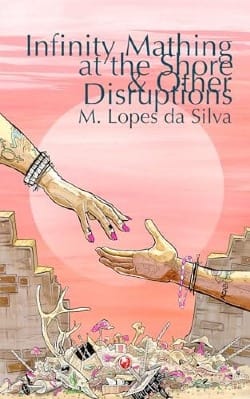
The world of publishing can be a dark and disheartening place, providing platforms to some of the worst people currently on the planet while ignoring those whose stories should be heard and need to be told. This is why the world of indie publishing, especially in the horror genre, has been integral to marginalized communities writing within the medium.
It's always a struggle when these publishers do their best to represent these communities, but are victim to capitalism in ways the big publishers typically aren't. That said, I love being able to bring light to books that absolutely hold the merit and space of a big name publisher, but maybe "fall under the radar" due to an indie release. Weirdpunk, who published this superb story collection, have been releasing some of the coolest and weirdest horror of the last few years, and I am so happy that they offered M. Lopes da Silva the space to release their transformative work into the world.
Infinity Mathing at the Shore & Other Disturbances is trans horror and weird fiction at its finest. Queer, jaw-dropping, disturbing, hopeful, devastating–so many spectrums of human emotion are explored in Lopes da Silva's poetic prose that makes some disturbing sequences sound utterly gorgeous. Two friends experience a transformative hookup at a long-abandoned shore location, deer in the Hollywood Hills become murderous under the influence of bizarre glitter cast aside by the elite, an experimental artists exploits the love of an admirer, utilizing her body for his depraved desires–there is untethered darkness and wit throughout their stories.
Capitalism, transphobia/transmisogyny, celebrity, obsession? Everything is on the table in this collection and Lopes da Silva spares no one in their critiques. A punk spirit is felt across the collection, caring not an iota for decorum or rules of physics in its own continuum. The stories embody transness in multifaceted arrays of morality and transformation, blasting open the doors of speculative fiction to deliver something so comfortingly unique.
I now hunger for further M. Lopes da Silva writings and I am beyond excited for what they release next. I truly hope that this book receives the accolades and eyes it justly deserves. Perfect for all fans of weird horror fiction, Infinity Mathing at the Shore & Other Disturbances is a stunning 2024 hit and should absolutely be on your TBR as the year trudges on.
Woof, that was a lot. Thank you for sticking through to the end. I always greatly appreciate anyone's patience when it comes to my ramblings about books, so I thank you all for being here.
Hopefully this piece has allowed you some space to think about and challenge your thoughts regarding the archetype and theme of redemption. May all, or at least some, of them make it into your reading this year.
Catherine McCarthy can be found @catherine_mccarthy_author on Instagram.
Nick Medina can be found @nickmedinawrites on Instagram.
Paul Tremblay can be found @paulgtremblay on Instagram.
Beth Hetland can be found @bethhetland on Instagram.
M. Lopes da Silva can be found @authormlopesdasilva on Instagram.

